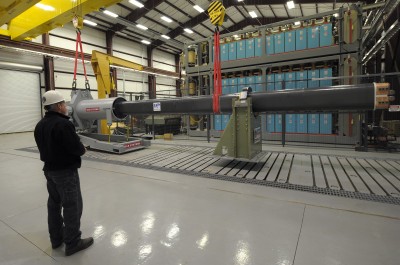
Gary Bass, from the Naval Surface Warfare Center in Dahlgren, Va., uses a crane to maneuver a 32-MJ version of the Office of Naval Research-funded Electromagnetic Railgun (EMRG) prototype into place for government evaluation. The EMRG is a long-range weapon that launches projectiles using electricity instead of chemical propellants and is under development by the Department of the Navy for use aboard ships. (U.S. Navy photo by John F. Williams/Released)
By Grace Jean, Office of Naval Research
ARLINGTON, Va. (February 7, 2012)-The Office of Naval Research (ONR)'s Electromagnetic (EM) Railgun program will take an important step forward in the coming weeks when the first industry railgun prototype launcher is tested at a facility in Dahlgren, Va., officials said Feb. 6.
"This is the next step toward a future tactical system that will be placed on board a ship some day," said Roger Ellis, program manager of EM Railgun.
The EM Railgun launcher is a long-range weapon that fires projectiles using electricity instead of chemical propellants. Magnetic fields created by high electrical currents accelerate a sliding metal conductor, or armature, between two rails to launch projectiles at 4,500 mph to 5,600 mph.
With its increased velocity and extended range, the EM Railgun will give Sailors a multi-mission capability, allowing them to conduct precise naval surface fire support, or land strikes; cruise missile and ballistic missile defense; and surface warfare to deter enemy vessels. Navy planners are targeting a 50- to 100-nautical mile initial capability with expansion up to 220 nautical miles.
The EM Railgun program, part of ONR's Naval Air Warfare and Weapons Department, previously relied upon government laboratory-based launchers for testing and advancing railgun technology. The first industry-built launcher, a 32-megajoule prototype demonstrator made by BAE Systems, arrived at Naval Surface Warfare Center (NSWC) Dahlgren Jan. 30. One megajoule of energy is equivalent to a 1-ton car traveling at 100 miles per hour.
"This industry prototype represents a step beyond our previous successful demonstrations of the laboratory launcher," Ellis said.
The prototype demonstrator incorporates advanced composites and improved barrel life performance resulting from development efforts on the laboratory systems located at the Naval Research Laboratory (NRL) and NSWC-Dahlgren. The EM Railgun laboratory demonstrator based at NSWC-Dahlgren fired a world record setting 33-megajoule shot in December 2010.
The industry demonstrator will begin test firing this month as the EM Railgun program prepares for delivery of a second prototype launcher built by General Atomics.
In the meantime, the Navy is pushing ahead with the next phase of the EM Railgun program to develop automatic projectile loading systems and thermal management systems to facilitate increased firing rates of the weapon.
"The next phase of the development effort is to demonstrate the ability to operate at a firing rate of significant military utility," Ellis said.
ONR recently awarded $10 million contracts through Naval Sea Systems Command to Raytheon Corp., BAE Systems and General Atomics to develop a pulsed power system for launching projectiles in rapid succession. These new contracts kick off a five-year effort to achieve a firing rate of six to 10 rounds per minute.
BAE Systems and General Atomics also are commencing concept development work on the next-generation prototype EM Railgun capable of the desired firing rate.


